

The 8 Elements Project-Based Learning Must Have. If you’re contemplating using Project-Based Learning or are already trying out the latest craze to hit the modern classroom, you should know about this checklist. It details if you’re actually doing it correctly. For example, does your project focus on significant content, develop 21st century skills, and engage students in in-depth inquirty (just to name a few)?
If not, you might want to reconsider your PBL approach. What’s the Difference Between “Doing Projects” and “Project Based Learning”? The Muppets Guide to Project-Based Learning (PBL) One of my goals for this upcoming year is to create a project-based learning (PBL) unit for my World History class.
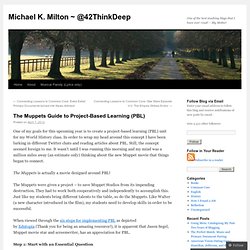
In order to wrap my head around this concept I have been lurking in different Twitter chats and reading articles about PBL. Still, the concept seemed foreign to me. What Project-Based Learning Is — and What It Isn’t. Screenshot/High Tech High The term “project-based learning” gets tossed around a lot in discussions about how to connect students to what they’re learning.
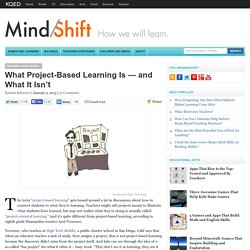
Teachers might add projects meant to illustrate what students have learned, but may not realize what they’re doing is actually called “project-oriented learning.” And it’s quite different from project-based learning, according to eighth grade Humanities teacher Azul Terronez. Terronez, who teaches at High Tech Middle, a public charter school in San Diego, Calif says that when an educator teaches a unit of study, then assigns a project, that is not project-based learning because the discovery didn’t arise from the project itself. Ramping Up Technology for Your Next PBL Project. In my last post about taking PBL projects up a notch, I focused on integration of subject matters and disciplines.
Fittingly, this post focuses on integrating technology. Teachers often adjust and improve projects by finding new and innovative ways to infuse technology into the PBL process and products. However, it's not about more technology tools, but about the intentional use of the tools available. In my classroom, one of the driving forces for reflection in terms of technology integration is the Technology Integration Matrix from the Florida Center for Instructional Technology. Maker High: Why Every School Should Be a Maker Faire. The prevailing problem with American high schools is boredom.
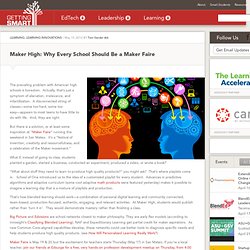
Actually, that’s just a symptom of alienation, irrelevance, and infantilization. A disconnected string of classes—some too hard, some too easy—appears to most teens to have little to do with life. And, they are right. But there is a solution, or at least some inspiration at “Maker Faire” running this weekend in San Mateo. It’s a “festival of invention, creativity and resourcefulness, and a celebration of the Maker movement.”
Assignments - ECMP 455. PBL. Secret to Better PBL? Focus on Problem-Finding. On April 22, a billion people around the world are expected to take part in Earth Day 2012 celebrations.
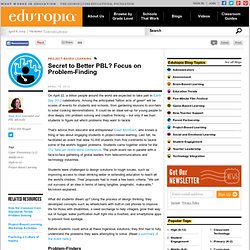
Among the anticipated "billion acts of green" will be scores of events for students and schools, from gardening lessons to eco-fairs to solar cooking demonstrations. It could be an ideal set-up for young people to dive deeply into problem solving and creative thinking -- but only if we trust students to figure out which problems they want to tackle. That's advice from educator and entrepreneur Ewan McIntosh, who knows a thing or two about engaging students in project-based learning. Last fall, he facilitated an event that drew 10,000 students from five continents to tackle some of the world's biggest problems. Students came together online for the ITU Telecom World Meta Conference. Students were challenged to design solutions to tough issues, such as improving access to clean drinking water or extending education to reach all the world's children.
SCIL – Lead the change. Student-Centered Learning. Designing Schools for 21st Century Learning, Randall Fielding Randall Fielding, AIA, is the Chairman and Founding Partner of Fielding Nair International, LLC (FNI), an award-winning school planning and design firm with offices in Minneapolis, Tampa, Madison and Melbourne, Australia.
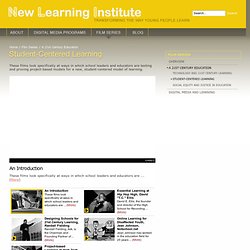
The firm has consultations in 23 states around the U.S. and 26 countries. Randy oversees FNI’s primary mission to improve learning by serving as a world leader in the creation of new and renovated educational campuses that are in consonance with best practice and research. Fielding’s achievements have earned him more than a dozen design awards from the American Institute of Architects, The Council of Educational Facility Planners International (CEFPI), the American Association of School Administrators, and School Planning and Management Magazine.
Sydney school embraces new teaching model. Project Based Learning. (image from education-world.com) Project Based Learning (PBL) is a great way to teach students content, 21st century skills, and engage them in something fun and educational.
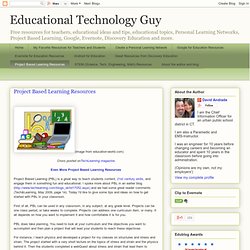
I spoke more about PBL in an earlier blog ( and we had some great reader comments (Tech&Learning, May 2009, page 14). Today I'd like to give some tips and ideas on how to get started with PBL in your classroom. First of all, PBL can be used in any classroom, in any subject, at any grade level. Projects can be one class period, or take weeks to complete. A Parent's Guide to 21st-Century Learning. You’ll find a selection of outstanding online resources and projects, sorted by grade levels, to provide a glimpse of successful school programs.
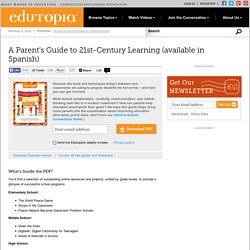
Elementary School: The World Peace Game Skype in the Classroom Peace Helpers Become Classroom Problem Solvers Middle School: Down the Drain Digiteen: Digital Citizenship for Teenagers World of Warcraft in School High School: World Youth News Digital Youth Network Money Corps: Finance Experts as Guest Teachers Across the Grades: More Ideas that Work Ten Tips to Bring 21st-Century Skills Home Resources: Bring the C's to Your School. REINVT-excerpt. Authentic, Hands-on Learning with Career and Technical Education. I am a daily witness to outlandish potential and even more incredible reality as I see students fabricating complicated ductwork, reworking the plugs and wires on a V8 engine and interpreting the bitewing X-rays of dental patients.
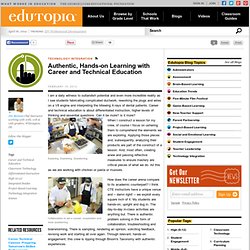
Career and technical education is about differentiated instruction, higher levels of thinking and essential questions. Can it be more? Is it more? Exploring. Examining. When I construct a lesson for my crew, of course I focus on ushering them to comprehend the elements we are exploring. Collaboration to set a course; cooperation and more questioning.
How does the career arena compare to its academic counterpart? End product. I remember my education psych class (which I was forced to take when I left the cooking field) and the very last words the instructor offered us. Sampling. Project-Based Learning Made Easy. "Project-based learning is great but it is too hard for teachers to do well.
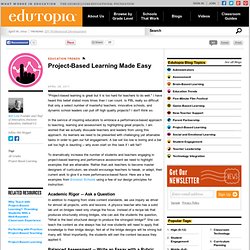
" I have heard this belief stated more times than I can count. Is PBL really so difficult that only a select number of masterful teachers, innovative schools, and dynamic school leaders can pull off high quality projects? Congoo News. Internet Catalogue. Helping Parents Understand PBL. Wright'sRoom. I love project-based learning.
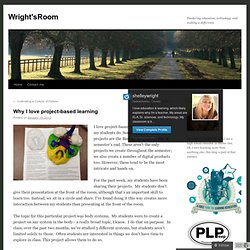
Why? Because my students do. Some of my favourite projects are the Biology 30 projects due at semester’s end. These aren’t the only projects we create throughout the semester; we also create a number of digital products too. However, these tend to be the most intricate and hands on. For the past week, my students have been sharing their projects. The topic for this particular project was body systems. One of my students created a Monopoly-type boardgame based on the nervous system. Each of the different properties represented a different aspect of the nervous system. But the best part of his presentation, to me, was when he stated, “I really enjoyed doing this. Another student researched and created a model of the knee. A third student created two cakes — each depicted the brain. Powerful. Tlc-proposal-10-18-11.docx. TLC Middle School (opening August 2013) We are running affordable summer camp sessions from 8:45-noon during the week of July 8-12 in Durham, NC. Click here for details.
Student applications for 2013-14 are now available;Please click this link for the 2013-14 TLC Application. TLC in the Durham Press Read this article about TLC in the Duke student newspaper.Read another article about TLC from the Durham Herald-Sun. For more information about TLC, please contact Steve Goldberg – Steve [at] Trianglearning.org (note that it’s not Trianglelearning — there’s a shared “le”) Please click here for a 2-page Executive Summary describing TLC.
Please see Steve’s blog, What I Learned Today, for examples of the sort of active learning that will take place at TLC. Make: Kit Reviews. Life in a Inquiry Driven, Technology-Embedded, Connected Classroom: Science. I teach in an inquiry, project-based, technology embedded classroom. A mouthful, I know. So what does that mean? It means I lecture less, and my students explore more. It means that I create a classroom where students encounter concepts, via labs and other methods, before they necessarily understand all the specifics of what is happening. It’s a place where my students spend time piecing together what they have learned, critically evaluating its larger purpose, and reflecting on their own learning. It also means my students don’t acquire knowledge just for the sake of acquiring it. Into play. So what does this look like? On lab days, one of the first things my students do is take out their phones. I used to have students sketch pictures of lab slides.
George Demo. Web 2.0 to support the nets. Web Tools that support this standard •Gizmos ExploreLearning currently has over 450 Gizmos with accompanying curricular materials, all with the aim of sharing the “Ah-Hah!” Moment with teachers and students. • SAS Curriculum Simulations By integrating technology and instruction, SAS Curriculum Pathways helps students master the core disciplines in an efficient, cost-effective manner. • Google Earth Google Earth lets you fly anywhere on Earth to view satellite imagery, maps, terrain, 3D buildings, from galaxies in outer space to the canyons of the ocean. . • Earth Browser. Seven Ways to Build Your Own Educational Games. There are hundreds of places to find educational games and quizzes on the Internet. Get Globally Connected. QR Codes in Education. Project Based Learning.
Project-Based Learning. Project Based Learning. Critical & Creative Education.